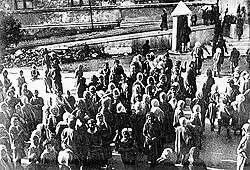The Ottoman Empire was the foremost power of the Eastern Mediterranean for several centuries during the late medieval and early modern periods. Osman I or Othman founded the Ottoman Empire in the early fourteenth century. After conquering the Byzantine Empire with the capture of Constantinople (Istanbul) in 1453, it embarked on a period of major expansion. By the end of the sixteenth century, Ottoman rule extended from Hungary south to Egypt and the Arabian Peninsula and from Algeria east to Iraq. The empire stagnated in the eighteenth century and began to lose lands to Austria, Russia and various independence movements in the Balkans from the 1770s onwards. As this occurred, Muslims from lands which had once formed part of the Ottoman Empire but were now lost began migrating towards Thrace and Anatolia in what is now Turkey. Between the late eighteenth century and the end of the twentieth century an estimated 10 million Muslims migrated in this manner and these people are known as the Muhacir (‘migrant’). Upwards of 30 million of Turkey’s 85 million inhabitants today are believed to be descendants of Muhacir.[1]
Research your ancestors on MyHeritage
Chronology of eventsChronology of events

The Ottoman Empire first emerged in the early fourteenth century as a Turkish warlord in western Anatolia by the name of Osman Ghazi or Othman began carving out a principality for himself there out of the ruins of what had once been the powerful Seljuk Empire. In the decades that followed, Osman I (after whom the empire would subsequently take its name) and his successors conquered lands across Anatolia and on the other side of the Bosporus in the region approximate to Bulgaria, Macedonia and northern Greece. But it was only in 1453 when Sultan Mehmed II conquered Constantinople (modern-day Istanbul) and finally brought the Byzantine, or Eastern Roman Empire, to an end that the Ottomans were recognized as a major emerging power. Over the next century they conquered all before them, including most of the Middle East, North Africa as far west as Algeria, the northern shores of the Black Sea, the Caucasus and most of the Balkans. By the end of the sixteenth century they were threatening Austria and as late as 1683 they threatened to capture the city of Vienna.[2]
As powerful as the Ottomans were in the fifteenth, sixteenth and seventeenth centuries, they entered into a period of rapid stagnation and decline in the eighteenth. This was owing to the weakness of their own rulers and the indolence of their elites, but also because they were falling behind the European powers who were rapidly innovating through new scientific and technological discoveries. As a result, beginning in the 1770s Austria and Russia began seizing large parts of land from the Ottomans in a series of wars over regions like the Crimea, Moldavia, the Caucasus and parts of modern-day Croatia and Bosnia. Compounding the problem, nationalist movements emerged in Greece, Serbia, Bulgaria and Romania and in the course of the nineteenth century these countries acquired independence from the Ottomans, which by then had become known as the ‘Sick Man of Europe’.[3]
The Ottomans had been a relatively tolerant power from a religious perspective. Although an Islamic sultanate, the Turks had not actively persecuted Christians and positively welcomed the influx of Jews from countries like Spain in the sixteenth century.[4] However, it was still beneficial from a political, economic and social perspective to be a Muslim under Ottoman rule, and as a consequence a great many people converted in the Balkans from Eastern Orthodox Christianity in the course of the sixteenth, seventeenth and eighteenth centuries. What this meant was that by the time the Ottoman Empire began it’s decline, there were many people who belonged to one of the Balkan ethnic groups like Albanian, Bosniaks, Serbs, Greeks and Roma who had converted to Islam and were confirmed Muslims. This process was particularly acute in Albania.[5]
Many of these people believed, quite rightly in some instances, that they would suffer persecution under the rule of Christian powers like Austria and Russia, or within majority Eastern Orthodox states like Serbia, Greece, Romania and Bulgaria. Hence, as the Ottoman Empire declined and land was lost to other powers, many Muslims within these regions began migrating towards Turkey proper to live amongst their co-religionists. This process continued through the twentieth century, with a final wave occurring at the end of the Cold War as hundreds of thousands of Muslims left former communist countries like Bulgaria for Turkey. This was a massive migratory event between the late eighteenth century and late twentieth century.[6]
Extent of migrationExtent of migration
It is difficult to assess the exact extent of the migration which occurred as the Ottoman Empire declined and collapsed, as there were no systematic census records for the Ottoman Empire until 1831 and this did not cover the lands from which the Muhacir, or ‘migrants’ were arriving. This issue aside, demographers and population historians believe that there were about ten million Muslims relocated to Thrace and Anatolia in the period between the 1770s and 1920s. Most came from the former lands of the Ottoman Empire in the Balkans. Some Muhacir also came from further afield. For instance, when the French began conquering and colonizing Algeria, a former Ottoman territory, in the 1830s, they expelled thousands of Algerian Turks, many of whom were forcibly shipped to Izmir in western Anatolia.[7]

The migration was particularly intense at specific times, beginning in the 1770s as this was the period in which Russia and Austria first began acquiring lands from the Ottomans along the northern border of the empire in the Balkans. There was another large wave in the 1820s and 1830s as the Greeks fought for, and won, their independence. However, the real major waves of migration occurred from the late 1870s onwards as Romania, Serbia and Bulgaria secured their independence from the Ottomans at that time as part of the Russo-Turkish War of 1877–1878.[8]
Additional waves came following the independence of Albania and Montenegro during the Balkan Wars in the early 1910s. The final waves occurred in the twentieth century following the Turkish War of Independence, and the loss of the empire’s remaining territory outside of Turkey at the end of the First World War. For instance, in just one episode in this last stage of the migration, upwards of half a million Muslims moved from Greece to Turkey under the terms of the Convention Concerning the Exchange of Greek and Turkish Populations included in the Treaty of Lausanne of 1923 which brought the Greco-Turkish War to an end.[9]
Demographic impactDemographic impact
The descendants of the Muhacir are estimated to make up nearly 30 million of Turkey’s 85 million inhabitants today, or approximately one-third of the population. What this means is that many Turkish people today also have an ethnic heritage tied to parts of the Balkans or other regions like the Caucasus, Crimea or North Africa where their ancestors came from during this period of migration. While the descendants of the Muhacir live throughout Turkey, there is something of a concentration in western Turkey and European Turkey which were proximate to the Balkans and where most Muhacir settled during the 200-year period in question.[10]
See alsoSee also
Explore more about the Ottoman EmpireExplore more about the Ottoman Empire
- Greece, Asia Minor Refugees, 1914-1923 at MyHeritage
- Greece’s Top 5 Types of Genealogy Records at Legacy Family Tree Webinars
- Turkey-Greece population exchange still painful for those yearning for a lost past at Middle East Eye
References
- ↑ https://reviews.history.ac.uk/review/1690
- ↑ https://www.worldhistory.org/Ottoman_Empire/
- ↑ https://encyclopedia.pub/entry/35768
- ↑ https://aspectsofhistory.com/ottoman-pathways-to-tolerance/
- ↑ https://www.cambridge.org/core/books/abs/concise-history-of-albania/albanians-under-ottoman-rule-the-classic-period-of-arnavutluk-15001800/43BE1409738A31D1BE783D6C77769D0E
- ↑ http://ieg-ego.eu/en/threads/europe-on-the-road/forced-ethnic-migration/berna-pekesen-expulsion-and-emigration-of-the-muslims-from-the-balkans
- ↑ https://thelausanneproject.com/2023/01/13/erol/
- ↑ https://journals.openedition.org/balkanologie/265
- ↑ https://www.oxfordbibliographies.com/display/document/obo-9780199796953/obo-9780199796953-0236.xml
- ↑ https://www.definitions.net/definition/muhacir

